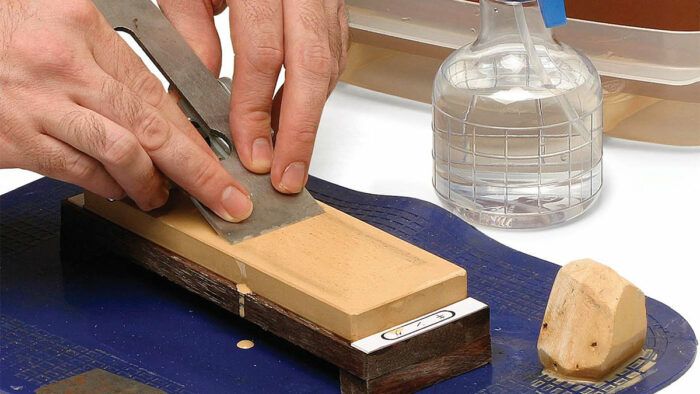A User’s Guide to Waterstones
There's no faster or more economical way to achieve razor-sharp tools

Synopsis: The more proficient you are at sharpening a blade, the more likely you are to keep your tools sharp. And sharp tools will help you raise the quality of your projects. In this article David Charlesworth shares his time-tested method for sharpening with waterstones. To get the most from waterstones, a disciplined approach to using, maintaining, and storing them is essential, and Charlesworth’s technique requires minimal effort.
Sharpness is a function of two polished surfaces meeting to form a cutting edge. The easier and quicker it is to polish these edges, the more likely you are to keep your tools sharp, and sharper tools will raise the quality of your woodworking projects.
My preferred method of sharpening is to use Japanese synthetic waterstones, and I recommend them to my students. They cut faster and give a better edge than most other sharpening systems. The grit size of an 8,000-grit stone is about 3 microns, meaning that scratches left by it may be no more than 1.5 microns deep. This is a much better polish than you get with alternatives such as translucent Arkansas, ceramic, or diamond stones.
The cost of a set of synthetic stones is less than that of most other sharpening systems. A basic set of stones—800 grit, 1,200 grit, and 6,000 grit with a Nagura honing stone—costs around $75. Substitute an 8,000-grit stone for a slightly finer polish, and the cost is still well under $100.
To get the best from these stones, a disciplined approach to both using and maintaining them is essential. I have developed a time-tested method for sharpening that requires minimal effort.
I store the coarser 800-grit and 1,200-grit stones on their sides in plastic trays of shallow water. A dash of household bleach can be added to the water to slow down the growth of mold. Don’t store your stones in water if your workshop freezes at night, because the stones will shatter. Stones stored dry will be ready to use after a five-minute soak. Stones of 4,000 grit and finer always are stored dry and sprayed with water only prior to use.
My sharpening station also includes a simple stone-flattening device: 1⁄2-in.-thick float glass attached to a Corian base that drains the sludge back into the sink.
Because waterstones are designed to erode with use, in the hands of the inexperienced they quickly can develop a hollow profile. My sharpening technique minimizes hollowing, which is particularly helpful when flattening the backs of new plane and chisel blades. There are two types of stroke, the lengthwise stroke and the crosswise stroke, which refer to the orientation of the stone rather than the blade. Lay the blade across the 800-grit stone with its edge about 1⁄2 in. off the left edge of the stone.

From Fine Woodworking #169
For the full article, download the PDF below.
Fine Woodworking Recommended Products

Veritas Precision Square

Starrett 12-in. combination square

Lie-Nielsen No. 102 Low Angle Block Plane








Comments
This may have been true in 2004 when the article was published, but when I recently switched from water stones to high quality diamond stones I was astounded at the speed and superb results. I also hone on a leather strop. I haven't looked at my edges under a microscope, but I know how they perform, and I am not going back to waterstones.
I don't think you can get quality in a set of three waterstones for $75. I pay at least that much for one stone. There is a big difference in quality and surface area. King stones are rubbish and they aren't wide enough to lap my No. 8 plane blade. Sigma stones are really good.
Log in or create an account to post a comment.
Sign up Log in